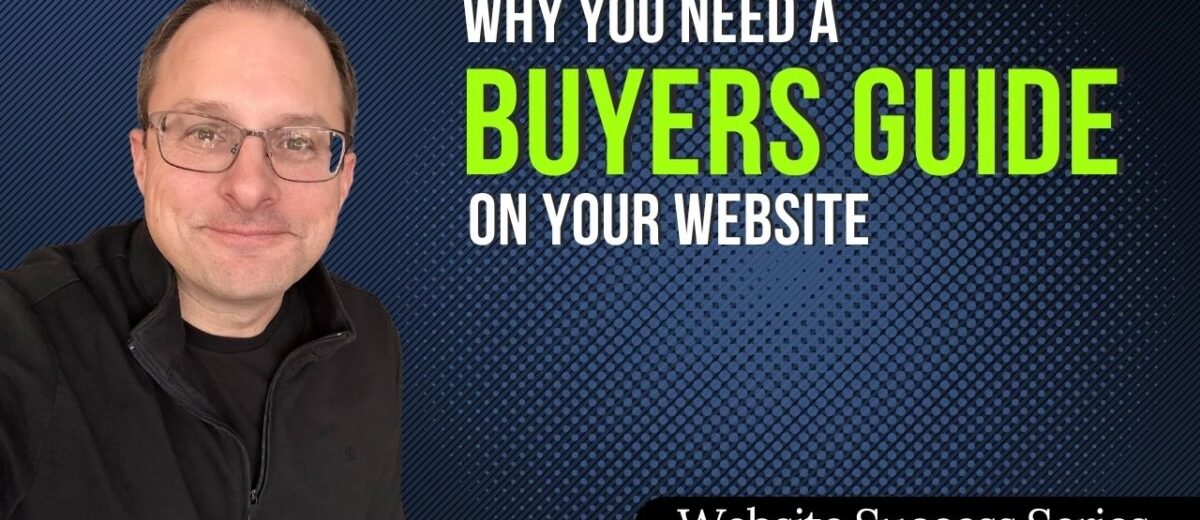Why a Buyer’s Guide Helps You Earn Trust Before the Sale
Some businesses believe sales should handle customer education. But what about the people who aren’t ready for a sales conversation yet?
Not everyone who visits your website is ready to talk to someone. Some are just starting their research, some are gathering information for someone else, and others simply want to take their time before making a decision.
A Buyer’s Guide gives them the freedom to learn at their own pace—without pressure. And when they’re ready, they’ll already trust you.
Why a Buyer’s Guide Works (And Why Most Businesses Don’t Have One)
Some business owners don’t know how to create a Buyer’s Guide. Others assume their sales team should be the only source of information. But here’s the reality: Customers don’t want to feel like they have to talk to someone just to understand what they’re buying.
- It builds trust before the first conversation. When people can research comfortably, they feel more confident moving forward.
- It reduces hesitation and objections. A strong Buyer’s Guide answers common concerns before they become roadblocks.
- It makes sales conversations more productive. Instead of answering the same basic questions over and over, your sales team can focus on meaningful discussions.
- It creates a better buying experience. Instead of feeling overwhelmed, customers have a clear resource that guides them.
A Buyer’s Guide isn’t about convincing—it’s about helping. And that can make all the difference.
How a Solar Company Used a Buyer’s Guide to Save Time and Build Trust
A residential solar company was getting flooded with customer questions. Homeowners were unfamiliar with the buying process, and there were a lot of moving pieces to consider.
The problem? It was taking up to two days just to get back to people with basic answers because the team was overwhelmed with the same repetitive questions.
The solution? They created a Buyer’s Guide that pulled together all the FAQs from their website into a single, easy-to-read resource. It was available as a downloadable PDF, giving customers a way to:
- Read at their own pace—without pressure.
- Share it with others—especially in households where multiple people were involved in the decision.
- Come back to it later—when they were ready to move forward.
Here’s what happened next:
- Customers appreciated the guide so much, they actually thanked the company for putting it together.
- The team reduced call volume by cutting down on repetitive questions.
- When people did reach out, they were already well-informed and ready to talk seriously about solar.
Lesson: A Buyer’s Guide doesn’t replace sales—it makes sales more effective by creating better-prepared, more confident buyers.
What Makes a Great Buyer’s Guide?
The biggest mistake businesses make with a Buyer’s Guide? Turning it into a sales pitch.
A strong Buyer’s Guide should feel like a trusted resource, not a brochure. Here’s what it should include:
- Empathetic Positioning – Speak to your customers’ concerns, not just your product’s features.
- Frequently Asked Questions (FAQs) – Address common objections upfront so customers don’t have to dig for answers.
- Clarity & Simplicity – Keep it easy to read, easy to navigate, and focused on what matters most.
- Comparison & Decision-Making Help – Provide objective information to help buyers make the best choice—even if that means they don’t choose you.
- Visual Aids & Examples – Use images, checklists, or short videos to make it more engaging.
- A Trusted Advisor Approach – This should not feel like a sales pitch. It should feel like guidance from an expert who wants to help them make the best decision.
How to Create One for Your Business
If you don’t have a Buyer’s Guide yet, here’s how to get started:
- Step 1: Gather Common Customer Questions – What do people ask your sales team before buying? What concerns do they have?
- Step 2: Think from the Customer’s POV – If you were in their shoes, what information would make you feel confident about moving forward?
- Step 3: Structure It for Easy Reading – Organize the guide into sections, add bullet points, and make it scannable so people don’t feel overwhelmed.
- Step 4: Make It Accessible – Offer it as a downloadable PDF, link to it from your website, and even print copies if relevant.
- Step 5: Keep It Updated – As customer needs evolve, your Buyer’s Guide should too.
Your Prospects Will Thank You for This
The solar company didn’t create their Buyer’s Guide because they had to. They did it because their customers needed it. And the response they got made it clear—it wasn’t just useful, it was appreciated.
When you take the time to educate rather than just sell, people notice. And when they’re ready to buy, they’ll choose the company that made them feel confident in their decision.
So—does your business have a Buyer’s Guide? If not, it might be time to create one. Your customers (and your sales team) will thank you for it.
